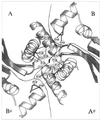Hyperthermophilic enzymes: sources, uses, and molecular mechanisms for thermostability
- PMID: 11238984
- PMCID: PMC99017
- DOI: 10.1128/MMBR.65.1.1-43.2001
Hyperthermophilic enzymes: sources, uses, and molecular mechanisms for thermostability
Abstract
Enzymes synthesized by hyperthermophiles (bacteria and archaea with optimal growth temperatures of > 80 degrees C), also called hyperthermophilic enzymes, are typically thermostable (i.e., resistant to irreversible inactivation at high temperatures) and are optimally active at high temperatures. These enzymes share the same catalytic mechanisms with their mesophilic counterparts. When cloned and expressed in mesophilic hosts, hyperthermophilic enzymes usually retain their thermal properties, indicating that these properties are genetically encoded. Sequence alignments, amino acid content comparisons, crystal structure comparisons, and mutagenesis experiments indicate that hyperthermophilic enzymes are, indeed, very similar to their mesophilic homologues. No single mechanism is responsible for the remarkable stability of hyperthermophilic enzymes. Increased thermostability must be found, instead, in a small number of highly specific alterations that often do not obey any obvious traffic rules. After briefly discussing the diversity of hyperthermophilic organisms, this review concentrates on the remarkable thermostability of their enzymes. The biochemical and molecular properties of hyperthermophilic enzymes are described. Mechanisms responsible for protein inactivation are reviewed. The molecular mechanisms involved in protein thermostabilization are discussed, including ion pairs, hydrogen bonds, hydrophobic interactions, disulfide bridges, packing, decrease of the entropy of unfolding, and intersubunit interactions. Finally, current uses and potential applications of thermophilic and hyperthermophilic enzymes as research reagents and as catalysts for industrial processes are described.
Figures








References
-
- Achenbach-Richter L, Gupta R, Stetter K-O, Woese C R. Were the original eubacteria thermophiles? Syst Appl Microbiol. 1987;9:34–39. - PubMed
-
- Adams M W W. Enzymes and proteins from organisms that grow near and above 100°C. Annu Rev Microbiol. 1993;47:627–658. - PubMed
-
- Adams M W W, Kelly R M. Enzymes from microorganisms from extreme environments. C & E News. 1995;73:32–42.
-
- Adams M W W, Perler F B, Kelly R M. Extremozymes: expanding the limits of biocatalysis. Bio/Technology. 1995;13:662–668. - PubMed
-
- Aguilar C F, Sanderson I, Moracci M, Ciaramella M, Nucci R, Rossi M, Pearl L H. Crystal structure of the β-glycosidase from the hyperthermophilic archeon Sulfolobus solfataricus: resilience as a key factor in thermostability. J Mol Biol. 1997;271:789–802. - PubMed
Publication types
MeSH terms
Substances
LinkOut - more resources
Full Text Sources
Other Literature Sources

